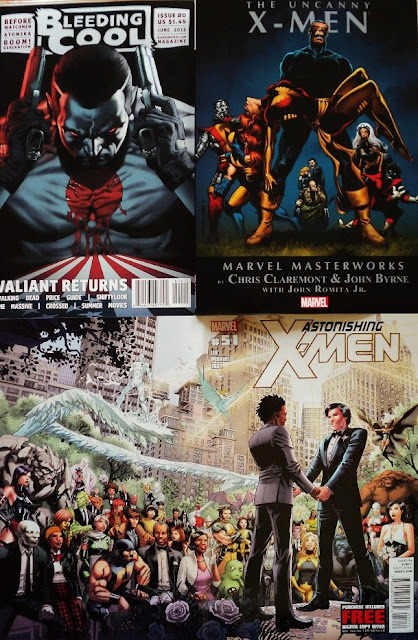However, a couple of years later this new Marvel title started to evolve, or rather to mutate in ways that perhaps Lee and Kirby hadn’t envisioned in 1963. If at the beginning being a mutant was a simply a way of explaining why certain individuals had superpowers, by 1965 being a mutant triggered a wide array of dramatic possibilities: intolerance, prejudice, bigotry, and so on. When Lee and Kirby completed the Sentinels saga, they set the foundations of the future tone of the series: instead of inconsequential and swashbuckling adventures, the X-Men would become a complex metaphor for discrimination and oppressed minorities.
In “Mythos: X-Men” (originally published in Mythos # 1, March 2006), British writer Paul Jenkins reinterprets the classic first issue of the X-Men, this time giving special attention to the discrimination between homo sapiens (regular people) and homo superior (mutants). The opening sequence this time revolves around Magneto, who is about to execute “three red-blooded American youths” who have committed a hate crime. They have murdered a 12-year-old mutant. And that is something that the Master of Magnetism cannot forgive. In an intense soliloquy, Magneto explains that hate crimes continue to be prevalent in the US: in the 50s, white supremacists would murder black men, in subsequent decades the victims would be gays.
One of my favorite moments takes place in the conversation between Professor X and Magneto. They both want to ensure the wellbeing of the mutant population, but they have such different approaches that they have become enemies. The conversation between Charles Xavier and the Master of Magnetism is an accurate portrayal of what makes these characters so essential to the Marvel Universe, and Jenkins excels at pointing out the political and philosophical differences of these two leaders.
 |
| Judge, Jury & Executioner / Juez, jurado y verdugo |
________________________________________________________________________________________________
________________________________________________________________________________________________
Hace más de medio siglo, Stan Lee y Jack Kirby crearon a los mutantes más famosos del mundo: los X-Men. Los primeros números fueron aventuras divertidas y de ritmo acelerado; eso es lo que los lectores esperaban de este legendario equipo creativo. Stan Lee ha explicado en algunas entrevistas que si los X-Men fueron mutantes en primer lugar esto no obedecía necesariamente a una motivación dramática. Cansado de inventar explicaciones pseudocientíficas (una araña radiactiva, una bomba gamma, rayos cósmicos, fórmulas químicas secretas, etc.), Stan Lee decidió que si todos los X-Men eran mutantes, entonces no tendría que explicar sus poderes, ya que habían nacido de esa manera, y cada uno de ellos poseía una habilidad X-tra que los convertía en X-Men.
 |
| Iceman (Bobby Drake), Beast (Hank McCoy), Angel (Warren Worthington III), Cyclops (Scott Summers) & Marvel Girl (Jean Grey) |
 |
| Professor X and his students / el profesor X y sus estudiantes |
 |
| X-Men versus Magneto |
"Mythos" fue pintado enteramente por Paolo Rivera en un estilo que mezcla con fluidez el realismo y el expresionismo. En la viñeta que muestra a los X-Men por primera vez, podemos ver claramente que cada rostro ha sido inspirado por un modelo de la vida real, y sin embargo la imagen conserva una cualidad especial, una cierta libertad creativa y mágica que convierten a esta página en un logro artístico que nunca está restringido por el realismo estricto o el expresionismo puro. Cada página ilustrada por Rivera es deliciosa, y uno no puede evitar admirar por varios minutos sus elegantes pinceladas y su vívida y rica paleta de colores.










